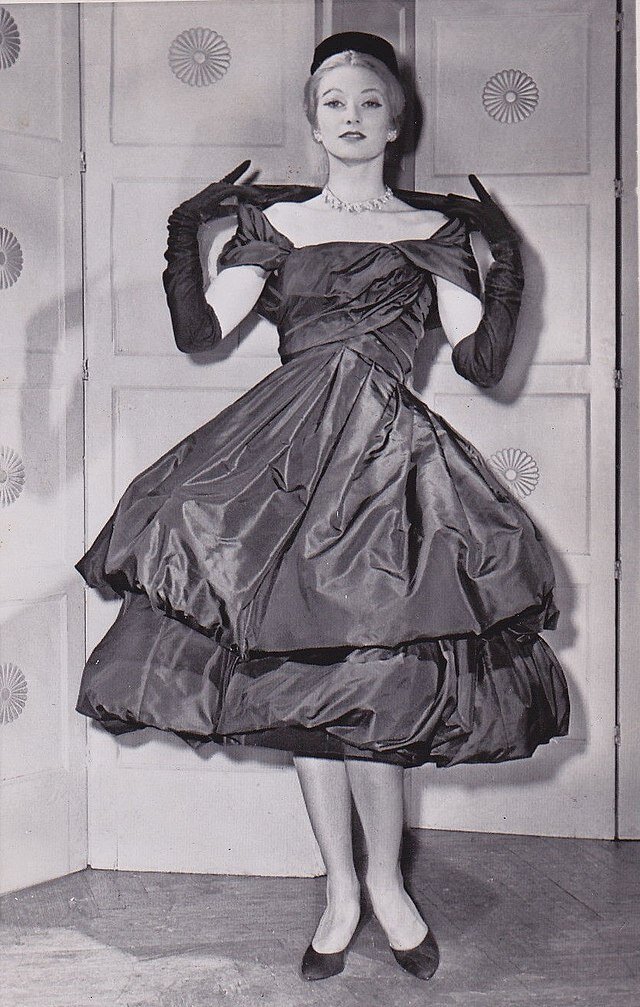Welcome to the “Fabric Junkie”!
I’m an unashamed fabric junkie. I love the look, feel, and textures of fabrics of all kinds. In fact, part of the reason I collect, wear, and sell vintage clothing is for love of fabric. The right fabric makes a good design better and can turn a mediocre design into a masterpiece.
Today I’ll tackle a basic topic: fiber and weave. As both a seller and buyer of vintage apparel, I’m dismayed when I ask a seller about the fiber from which an item is made, and she or he doesn’t understand what I’m asking. Especially if the weave is stated in the description. But that’s only half the story. Fabric is a combination of fiber and weave, fiber being the raw material used to create it (e.g., wool, silk, rayon, polyester) and weave being the resulting look and texture once it is made into yardage. There is also the “how” of creating fabric (weaving, knitting, compressing, bonding, etc.), which affects weave, but that’s another can of worms for another day. Let’s keep it simple today!
“So, why is this important?,” one might ask. While some buyers don’t care what fiber a garment is made of, many do. Some can’t wear synthetics, some can’t wear certain natural fibers. For others, it’s a matter of preference. A buyer may want to know the fiber and weave in order to get a sense of how the fabric will feel and drape (or not) on the body. And, for both buyers and sellers, knowing the fiber can determine how to care for/clean/store the garment.
This subject is so expansive and can be so complex, I don’t expect every seller to be a fabric expert! But, since fiber-content labels are a relatively recent development in apparel manufacturing, all sellers need a basic understanding of fiber and weave, and how to recognize them.
People often know weaves but don’t realize that several different fibers can be used to create the same weave. This seems to commonly occur with satin, taffeta, chiffon, jersey, velvet, gabardine, jacquard, seersucker, tweed, and a few others. Since this would be a book if I addressed all of them, I’ll start with the first three:
Satin: Most folks know satin, that shiny, smooth-textured, “slippery” fabric from which many evening and wedding gowns, nicer lingerie, and some linings are made. It can be made from silk, rayon, and polyester, and, sometimes, acetate. Cotton satin is called “sateen.” De-lustered, or matte, satin is often done in silk and called “peau de soie.” It has a very subtle luster and is delightful!
Taffeta: Also a smooth, finely woven fabric with a sheen to it, but is “crisp” and usually thinner than satin. It was very popular in the full-skirted party dresses of the 50s, often layered with tulle. Now commonly used for dress and coat linings. Though we usually see it in acetate or rayon, it used to (decades ago) be primarily be made of silk. Nylon also can be woven into a taffeta finish—most notably the delightful Barbizon “Tafredda” slips (when I got my first one, I was astounded that it was 100% nylon!).
Chiffon: That sheer, thin, and airy fabric seen in party dresses, wedding gowns, lingerie, etc. Vintage double-chiffon peignoir sets have been popular for years. Chiffon is often used for billowy sleeves, ruffled trim, and bodice insets. When used for a full garment, it’s often lined in taffeta. It can be made from silk, nylon, polyester, and rayon.
How to tell the difference? The best way is through handling as many different known fibers and weaves as you can. Note the content and weave of modern and vintage garments you already have—how they feel, how they drape, etc. Go to the fabric store, take a bolt of silk satin and one of polyester satin, and compare the feel. There is nothing like “hands-on” practice! Identifying fabrics will become much easier over time. But, no matter how well versed you are, sometimes you just can’t tell. I have three sewing books I use as reference; after sewing for 50+ years and selling for 20+, I still check them. Often. You should also learn how to do a burn test for fibers you can’t identify. This isn’t always possible, but it can be valuable when it is. Visit our Fabric Resource “Determining Fiber” page for a chart, tips on methodology, etc. Bear in mind that any of the fabrics discussed today can consist of blends of fibers, and in that case, even a burn test may be inconclusive. It also takes awhile to get the hang of burn testing, but be patient. It pays off.
So, sometimes, if you’re a seller, you end up just not being sure. It’s fine to state your educated opinion as to fiber, disclosing that it’s your “best guess.” In online selling, where a buyer can’t handle an item, I think it’s critical to state, to the extent possible, the fiber and weave of a piece. This can keep your buyers happy and returns due to fabric surprises to a minimum.
Be sure to keep an eye out for the next installment of the “Fabric Junkie”!
Written by Anne Cook/Vintage Baubles, MyVintageCocktail on Etsy.

1959 Yves Saint Laurent for Christian Dior taffeta dress (public domain)